Samsung Prostar DCS 816 Programming Manual
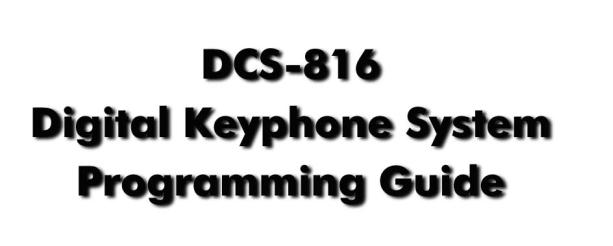
Technical Manuals Online! - http://www.tech-man.com
Technical Manuals Online! - http://www.tech-man.com

i
About This Manual
The DCS-816 digital keyphone system can easily change system settings by using the keyset.
An MMC (Man Machine Code) is a program, which sets up the system according to your needs. This chapter explains how to use a keyphone MMC program. It consists of four parts as follows.
yIntroduction to programming
yPrecautions before starting programming
yProgramming procedure
yProgramming using MMCs
Technical Manuals Online! - http://www.tech-man.com

ii |
DCS-816 Programming Guide |
Table of Contents
Chapter 1 |
Introduction to Programming ....................................................................................... |
1-1 |
|
PROGRAMMING OVERVIEW .................................................................................................................. |
1-1 |
|
PROGRAMMING LEVELS......................................................................................................................... |
1-1 |
Chapter 2 |
Programming Procedures............................................................................................. |
2-1 |
|
PROGRAM LIST........................................................................................................................................... |
2-1 |
|
PROGRAM PROCEDURES........................................................................................................................ |
2-2 |
|
DCS-816 DEFAULT DATA......................................................................................................................... |
2-3 |
|
SPECIAL APPLICATIONS ......................................................................................................................... |
2-8 |
Chapter 3 |
Programming Using MMCs............................................................................................. |
3-1 |
Technical Manuals Online! - http://www.tech-man.com

Technical Manuals Online! - http://www.tech-man.com
Technical Manuals Online! - http://www.tech-man.com

1-1
Chapter 1 Introduction to Programming
PROGRAMMING OVERVIEW
The DCS-816 system arrives from the factory with default data. Connect it to trunks, stations and power, turn the system on and it is fully operational. The only thing left to do is customise the data to fit the customer’s needs. This is called programming the system.
MMC stands for Man Machine Code and each program is assigned a different three-digit code (e.g. 100). These MMC codes are used to view, create or change customer data. Programming is simply deciding what needs to be done and knowing which MMC is used to do it. For example: use MMC 601 to create a station group; enter system speed dial numbers in MMC 705; and assign soft keys to individual keysets using MMC 722.
System programming may be done from any LCD 12B or 24B keyset. The first thing you must do is open system programming. As a security measure, a passcode must be known to do this. Figure 1–1 shows the keys on a display keyset that have special functions during programming.
|
|
|
This manual describes standard settings. Some MMC codes and default data may be different |
|
|
|
|
from those shown depending on the country selected in MMC 812. |
|
CAUTION |
||||
|
||||
PROGRAMMING LEVELS
There are three levels of programming: technician (or system), customer and station. Technician and customer levels are under passcode protection while station programming does not require a passcode.
To prevent conflicting data from being entered, only one person at a time can enter programming with the technician or customer passcode. While programming is in progress, normal system operation is not affected. For your convenience, the system displays [xxx PGM MODE] when another keyset is in programming mode.
Technician (System) level
This level is entered via MMC 800 and requires the technician’s passcode. It allows access to all system programs, station programs and maintenance programs.
Customer level
This level is entered via MMC 200 and requires the customer passcode. It allows access to station programs and system programs permitted by the technician in MMC 802. When using the customer passcode to access station programs, data for all stations can be viewed or changed.
Station level
All keysets can access station programs 102–121 without using a passcode. Each user can only change station data for his/her own keyset.
When an LCD 12B or 24B keyset is in programming mode, the display shows instructions, prompts and choices. Existing data is always displayed before it can be changed. The keystroke sequence for each MMC is detailed in the following pages.
However, before you begin entering customer data:
Technical Manuals Online! - http://www.tech-man.com

1-2 Chapter 1
Introduction to Programming
IMPORTANT
When installing this system, and before doing any other programming, use MMC 812 first to select your country code and to reset and clear memory. This will ensure that you begin with clean, default data.
Remember that to begin programming using an MMC you must press the TRSF key. When you have finished entering data for an MMC and wish to program another MMC, press the SPK key to store the data and advance to the next MMC. To end programming you must press the TRSF key again to store the data and exit programming.
Now begin entering customer data.
|
|
1 |
13 |
LEFT |
RIGHT |
2 |
14 |
|
|
||
SOFT |
SOFT |
3 |
15 |
|
|
4 |
16 |
|
|
5 |
17 |
|
|
6 |
18 |
DIAL |
|
7 |
A |
|
|
|
|
|
|
8 |
B |
|
|
9 |
C |
|
|
10 |
D |
|
|
11 |
E |
|
|
12 |
F |
SPECIAL KEY FUNCTIONS
FIGURE 1-1
Technical Manuals Online! - http://www.tech-man.com

Technical Manuals Online! - http://www.tech-man.com
Technical Manuals Online! - http://www.tech-man.com

2-1
Chapter 2 |
Programming Procedures |
||||
PROGRAM LIST |
|
|
|||
|
|
|
|
|
|
|
100: |
STATION LOCK |
401: |
C.O./PBX LINE |
|
|
101: |
CHANGE USER PASSCODE |
402: |
TRUNK DIAL TYPE |
|
|
102: |
CALL FORWARD |
403: |
TRUNK TOLL CLASS |
|
|
103: |
SET ANSWER MODE |
404: |
TRUNK NAME |
|
|
104: |
STATION NAME |
405: |
TRUNK NUMBER |
|
|
105: |
STATION SPEED DIAL |
406: |
TRUNK RING ASSIGNMENT |
|
|
106: |
STATION SPEED DIAL NAME |
407: |
FORCED TRUNK RELEASE |
|
|
107: |
KEY EXTENDER |
408: |
ASSIGN TRUNK MUSICON HOLD |
|
|
108: |
STATION STATUS |
409: |
TRUNK STATUS READ |
|
|
109: |
DATE DISPLAY |
410: |
ASSIGN DISA TRUNK |
|
|
110: |
STATION ON/OFF |
414: |
MPD/PRS SIGNAL |
|
|
111: |
KEYSET RING TONE |
415: |
REPORT TRUNK ABANDON DATA |
|
|
112: |
ALARM REMINDER |
418: |
CARD RESTART |
|
|
113: |
VIEW MEMO NUMBER |
419: |
BRI OPTION |
|
|
114: |
KEYSET VOLUME |
421: |
MSN DIGIT |
|
|
115: |
SET PROGRAMMEDMESSAGE |
422: |
ASSIGN TRUNK COS |
|
|
116: |
ALARM AND MESSAGE |
423: |
S/T MODE |
|
|
119: |
SET CLIP DISPLAY |
424: |
S0 MAPPING |
|
|
121: |
KEYSET LANGUAGE |
426: |
TRUNK GAIN CONTROL |
|
|
200: |
OPEN CUSTOMER PROGRAMMING |
428: |
ASSIGN TRUNK/TRUNK USE |
|
|
201 |
CHANGE CUSTOMERPASSCODE |
|
|
|
|
202: |
CHANGE FEATUREPASSCODES |
500: |
SYSTEM–WIDE COUNTERS |
|
|
203: |
ASSIGN UA DEVICE |
501: |
SYSTEM–WIDE TIMERS |
|
|
204: |
COMMON BELL CONTROL |
502: |
STATION–WIDE TIMERS |
|
|
205: |
ASSIGN LOUD BELL |
503: |
TRUNK–WIDE TIMERS |
|
|
206: |
BARGE–IN TYPE |
504: |
PULSE MAKE/BREAK RATIO |
|
|
207: |
ASSIGN VM/AA PORT |
505: |
ASSIGN DATE AND TIME |
|
|
208: |
ASSIGN RING TYPE |
506: |
TONE CADENCE |
|
|
209: |
ASSIGN ADD–ON MODULE |
507: |
ASSIGN AUTO NIGHT TIME |
|
|
210: |
CUSTOMER ON/OFF |
508: |
CALL COST |
|
|
211: |
DOOR RING ASSIGNMENT |
510: |
SLI RING CADENCE |
|
|
214: |
DISA ALARM RINGING STATION |
512: |
HOLIDAY |
|
|
219: |
COMMON RELAY SERVICE TYPE |
600: |
ASSIGN OPERATOR GROUP |
|
|
220: |
ISDN SERVICE TYPE |
601: |
ASSIGN STATION GROUP |
|
|
300: |
CUSTOMERON/OFFPERSTATION |
602: |
STATION GROUP NAME |
|
|
301: |
ASSIGN STATION COS |
603: |
ASSIGN TRUNK GROUP |
|
|
302: |
PICKUP GROUPS |
604: |
ASSIGN INTERNAL PAGE ZONE |
|
|
303: |
ASSIGN BOSS/SECRETARY |
605: |
ASSIGN EXTERNAL PAGE ZONE |
|
|
304: |
ASSIGN STATION/TRUNK USE |
606: |
ASSIGN SPEED BLOCK |
|
|
305: |
ASSIGN FORCED CODE |
607: |
UCD OPTIONS |
|
|
306: |
HOT LINE |
608: |
ASSIGN CLIP REVIEW BLOCK |
|
|
308: |
ASSIGN BACKGROUND MUSIC SOURCE |
700: |
COPY COS CONTENTS |
|
|
309: |
ASSIGNSTATIONMUSICONHOLD |
701: |
ASSIGN COS CONTENTS |
|
|
310: |
LCR CLASS OF SERVICE |
702: |
TOLL DENY TABLE |
|
|
312: |
ALLOW CLIP |
703: |
TOLL ALLOWANCE TABLE |
|
|
314: |
CONFIRM OUTGOING CALL |
704: |
ASSIGN WILD CHARACTER |
|
|
315: |
SET RELOCATION |
705: |
ASSIGN SYSTEM SPEED DIAL |
|
|
316: |
COPY STATION USABLE |
706: |
SYSTEM SPEED DIAL BY NAME |
|
|
317: |
ASSIGN STATION/STATION USE |
707: |
AUTHORISATION CODE |
|
Technical Manuals Online! - http://www.tech-man.com
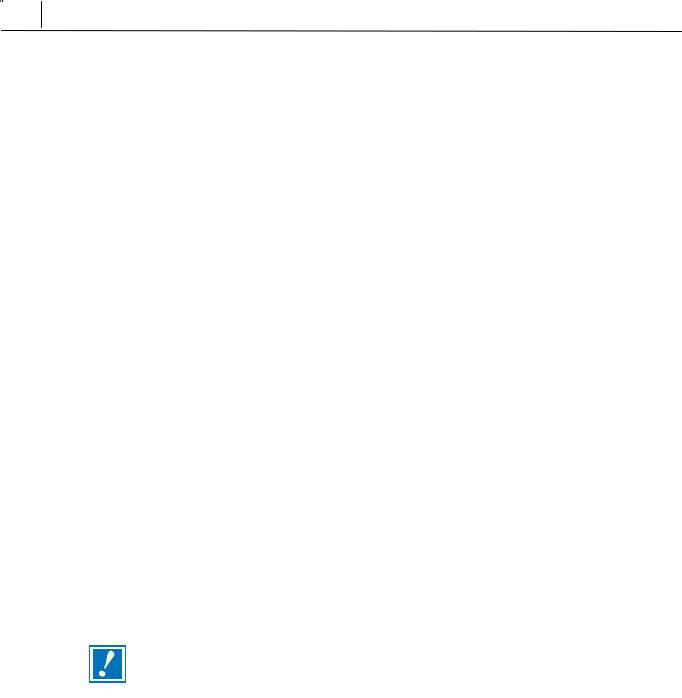
2-2 Chapter 2
Programming Procedures
318: |
DISTINCTIVE RING |
708: |
ACCOUNT CODE |
319: |
BRANCH GROUP |
709: |
TOLL PASS CODE |
400: |
CUSTOMER ON/OFF PER TRUNK |
710: |
LCR DIGIT TABLE |
711: |
LCR TIME TABLE |
736: |
ASSIGN AA MOH |
712: |
LCR ROUTE TABLE |
740: |
STATION PAIR |
713: |
LCR MODIFY DIGIT TABLE |
750: |
VMS RESTART |
714: |
DID NUMBER &NAME TRANSLATION |
751: |
ASSIGN MAILBOX |
715: |
PROGRAMMED STATION MESSAGE |
752: |
AUTO RECORD |
716: |
UK LCR OPTION |
753: |
WARNING DESTINATION |
718: |
MY AREA CODE |
754: |
VM HALT |
720: |
COPY KEY PROGRAMMING |
755: |
VM ALARM |
721: |
SAVE STATION KEYPROGRAMMING |
756: |
ASSIGN VM MOH |
722: |
Station Key Programming |
757 |
VM IN/OUT |
723: |
System Key Programming |
800: |
Enable Technician Program |
724: |
DIAL NUMBERING PLAN |
801: |
CHANGE TECHNICIAN PASSCODE |
725: |
SMDR Options |
802: |
CUSTOMER ACCESS MMC NUMBER |
726: |
VM/AA Options |
804: |
SYSTEM I/O PARAMETER |
727: |
SYSTEM VERSION DISPLAY |
805: |
TX LEVEL & GAIN |
728: |
CLIP TRANSLATION TABLE |
806: |
CARD PRE–INSTALL |
730: |
AA RECORD GAIN |
807: |
VOLUME CONTROL |
731: |
AA RAM CLEAR |
809: |
SYSTEM MMC LANGUAGE |
732: |
AA TRANS TABLE |
810: |
HALT PROCESSING |
733: |
AA PLAN TABLE |
811: |
RESET SYSTEM |
734: |
AA MESSAGE MATCH |
812: |
COUNTRY CODE |
735: |
AA USE TABLE |
|
|
PROGRAM PROCEDURES
The instructions for each MMC assume that you have already opened programming. First, run MMC 812, Country Code, to set your country (e.g U.K.) before you do any other programming.
This manual describes standard settings. Some MMC codes and default data may be different
from those shown depending on the country selected in MMC 812.
CAUTION
Helpful hint:
When you are finished programming in MMC codes 100–812 and have other programming to do, press SPK to exit the MMC but stay in the programming mode and use one of the following methods.
1.Dial another MMC code directly and continue programming.
2.Press VOLUME UP and DOWN keys to scroll through all MMC codes. When the desired MMC code is reached, press SPK and continue programming.
Pressing TRSF will always save changes and exit programming mode.
Technical Manuals Online! - http://www.tech-man.com

2-3
DCS-816 DEFAULT DATA
Station Programs
100: |
STATION LOCK |
All stations unlocked |
101: |
CHANGE USER PASSCODE |
All station passcodes = 1234 |
102: |
CALL FORWARD |
None |
103: |
SET ANSWER MODE |
All keysets ring |
|
|
Ring frequency default is 5 |
104: |
STATION NAME |
None |
105: |
STATION SPEED DIAL |
None |
106: |
STATION SPEED DIAL NAME |
None |
107: |
KEY EXTENDER |
None |
108: |
STATION STATUS |
PORT NUMBER: Follows H/W position |
|
|
TYPE: Follows phone type |
|
|
PICKUP GROUP: 01 |
|
|
SGR: NONE |
|
|
BOSS’SECR: NONE |
|
|
PAGE : NONE |
|
|
DAY COS NO: 01 |
|
|
NIGHT COS NO: 01 |
109: |
DATE DISPLAY |
COUNTRY: WESTERN |
|
|
CLOCK: 24 CLOCK |
|
|
DISPLAY: LOWER CASE |
110: |
STATION ON/OFF |
AUTO HOLD: OFF |
|
|
AUTO TIMER: ON |
|
|
HEADSET USE: OFF |
|
|
HOT KEYPAD: ON |
|
|
KEY TONE: ON |
|
|
PAGE REJOIN: ON |
|
|
RING PREFERENCE: ON |
|
|
CALL COST: OFF |
111: |
KEYSET RING TONE |
SELECTION 5 |
112: |
ALARM REMINDER |
Alarms set to NOTSET |
113: |
VIEW MEMO NUMBER |
No memos entered |
114: |
KEYSET VOLUME |
RING VOLUME: 4 |
|
|
OFF HOOK RING VOLUME: 4 |
|
|
HANDSET VOLUME: 4 |
|
|
SPEAKER VOLUME: 13 |
|
|
BGM VOLUME: 13 |
115: |
SET PROGRAMMEDMESSAGE |
No messages selected |
116: |
ALARM AND MESSAGE |
Alarms set to notset |
119: |
SET CLIP DISPLAY |
Number first |
121: |
KEYSET LANGUAGE |
ENGLISH |
Technical Manuals Online! - http://www.tech-man.com

2-4 Chapter 2
Programming Procedures
System Programs
200: |
OPEN CUSTOMERPROGRAMMING |
Closed (Disabled) |
201: |
CHANGE CUSTOMER PASSCODE |
Passcode = 1234 |
202: |
CHANGE FEATURE PASSCODES |
DAY/NIGHT 0000 |
|
|
DISA ALARM 5678 |
|
|
ALARM CLR 8765 |
|
|
AA RECORD 4321 |
203: |
ASSIGN UA DEVICE |
None |
204: |
COMMON BELL CONTROL |
Continuous |
205: |
ASSIGN LOUD BELL |
Unassigned |
206: |
BARGE–IN TYPE |
NO BARGE–IN |
207: |
ASSIGN VM/AA PORT |
NORMAL PORT |
208: |
ASSIGN RING TYPE |
ICM RING |
209: |
ASSIGN ADD–ON MODULE |
MASTER = NONE |
210: |
CUSTOMER ON/OFF |
DISA PSWD: ON |
|
|
LCR ENABLE: OFF |
|
|
PERI UCD SET: OFF |
|
|
CID CODE INS: OFF |
|
|
DISA MOH: OFF |
|
|
TRANSFER MOH: OFF |
|
|
DSP SSPDNAME: OFF |
|
|
DDI BSY ROUT: OFF |
|
|
DDI NOT ROUT: OFF |
|
|
ALL PICK UP: OFF |
|
|
ARD TONE CHK: ON |
|
|
VPN ENABLE: OFF |
|
|
IN TOLL CHK: OFF |
211: |
DOOR RING ASSIGNMENT |
Station group 500 |
214: |
DISA ALARM RINGING STATION |
DAY 500 |
|
|
NIGHT 500 |
219: |
COMMON RELAY SERVICE TYPE |
External Page |
220: |
ISDN SERVICE TYPE |
VOICE |
300: |
CUSTOMER ON/OFF PER STATION |
STN CALL PRT : OFF |
|
|
FWD DLY USE : OFF |
|
|
The others set to ON |
301: |
ASSIGN STATION COS |
Day class = 01 |
|
|
Night class = 01 |
302: |
PICKUP GROUPS |
All stations 01 |
303: |
ASSIGN BOSS/SECRETARY |
None |
304: |
ASSIGN STATION/TRUNK USE |
DIAL = Yes |
|
|
ANS = Yes |
305: |
ASSIGN FORCED CODE |
None |
306: |
HOT LINE |
None |
308: |
ASSIGN BACKGROUND MUSIC SOURCE |
None |
Technical Manuals Online! - http://www.tech-man.com

2-5
309: |
ASSIGN STATION MUSIC ON HOLD |
|
Tone |
310: |
LCR CLASS OF SERVICE |
|
Least Cost Routing COS 1 |
312: |
ALLOW CLIP |
|
REV YES |
|
|
|
SND YES |
|
|
|
INFO C.O Tel. |
314: |
CONFIRM OUTGOING CALL |
|
None |
315: |
SET RELOCATION |
|
None |
316: |
COPY STATION USABLE |
|
None |
317: |
ASSIGN STATION/STATION USE |
|
DIAL=Yes ANS=Yes |
318: |
DISTINCTIVE RING |
|
T=F–STN, C=F–STN |
319: |
BRANCH GROUP |
|
None |
400: |
CUSTOMER ON/OFF PER TRUNK |
|
1A2 EMULATE: Off |
|
|
|
TRUNK INC DND: Off |
|
|
|
TRUNK FORWARD: On |
|
|
|
LCR ALLOW: Off |
401: |
C.O./PBX LINE |
|
All Trunks C.O. Line |
402: |
TRUNK DIAL TYPE |
|
All Trunks DTMF |
403: |
TRUNK TOLL CLASS |
|
All Trunks F–STN day/night |
404: |
TRUNK NAME |
|
No names entered |
405: |
TRUNK NUMBER |
|
No numbers entered |
406: |
TRUNK RING ASSIGNMENT |
night: 500 |
All trunks day : 500 |
|
|
|
|
|
|
|
|
407: |
FORCED TRUNK RELEASE |
|
None |
408: |
ASSIGN TRUNK MUSICON HOLD SOURCE |
Tone |
|
409: |
TRUNK STATUS READ |
|
SEE MMC 409 |
410: |
ASSIGN DISA TRUNK |
|
All trunks normal |
414: |
MPD/PRS SIGNAL |
|
None |
415: |
REPORT TRK ABANDON DATA |
|
All trunks will report data |
418: |
CARD RESTART |
|
None |
419: |
BRI OPTION |
|
CHANNEL ANY: YES |
|
|
|
BRI MODE: P–P NOR |
|
|
|
DLSEND: OVERLAP |
421: |
MSN DIGIT |
|
NONE |
422: |
ASSIGN TRUNK COS |
|
DAY CLASS: 01 |
|
|
|
NIGHT CLASS: 01 |
423: |
S/T MODE |
|
TRUNK |
424: |
S0 MAPPING |
|
None |
426: |
TRUNK GAIN CONTROL |
|
RX=0dB, TX=0dB for all trunks |
428: |
ASSIGN TRK-TRK USE |
|
DIAL:Yes |
Technical Manuals Online! - http://www.tech-man.com

2-6 Chapter 2
Programming Procedures
500: |
SYSTEM–WIDE COUNTERS |
Alarm Rem Cntr=5 |
|
|
Auto Rdl Counter=5 |
|
|
DISA Call Cntr=99 |
|
|
DISA Lock Cntr=3 |
|
|
New Call Counter=99 |
|
|
UCD Visual Alarm=0 |
|
|
UCD Audio Alarm=0 |
|
|
UCD CS Level 1=0 |
|
|
UCD CS Level 2=0 |
501: |
SYSTEM–WIDE TIMERS |
SEE MMC 501 |
502: |
STATION–WIDE TIMERS |
SEE MMC 502 |
503: |
TRUNK–WIDE TIMERS |
SEE MMC 503 |
504: |
PULSE MAKE/BREAK RATIO |
Make/Break = 33 |
|
|
Pulses Per Second = 10 |
505: |
ASSIGN DATE AND TIME |
Follows software version release data |
506: |
TONE CADENCE |
SEE MMC 506 |
507: |
ASSIGN AUTO NIGHT TIME |
None |
508: |
CALL COST |
UNIT COST PER MP: 200 |
|
|
PENCE |
|
|
CALL COST RATE: 100% |
510: |
SLI RING CADENCE |
SEE MMC 510 |
512: |
ASSIGN HOLIDAY |
None |
600: |
ASSIGN OPERATOR GROUP |
DAY:500 NIGHT:500 |
601: |
ASSIGN STATION GROUP |
SEE MMC 601 |
602: |
STATION GROUP NAME |
None |
603: |
ASSIGN TRUNK GROUP |
All analogue trunks are in group 9 |
|
|
All digital trunks are in group 80 |
604: |
ASSIGN STATION TO PAGE ZONE |
No stations assigned |
|
|
All zone is set |
605: |
ASSIGN EXTERNAL PAGE ZONE |
None |
606: |
ASSIGN SPEED BLOCK |
System: 200 entries(20 blocks) |
|
|
Stations: One bin of 10 entries |
|
|
(1 block) |
607: |
UCD OPTIONS |
SEE MMC 607 |
608: |
ASSIGN CLIP REVIEW BLOCK |
One bin of 10 entries |
700: |
COPY COS CONTENTS |
None |
701: |
ASSIGN COS CONTENTS |
SEE MMC 701 |
702: |
TOLL DENY TABLE |
All entries are set to 0 |
703: |
TOLL ALLOWANCE TABLE |
All entries are set to 0 |
704: |
ASSIGN WILD CHARACTER |
All entries are set to 0 |
705: |
ASSIGN SYSTEM SPEED DIAL |
None |
706: |
SYSTEM SPEED DIAL BY NAME |
No names |
707: |
AUTHORISATION CODE |
COS: 01 |
Technical Manuals Online! - http://www.tech-man.com

2-7
708: |
ACCOUNT CODE |
None |
|
|
709: |
TOLL PASS CODE |
None |
|
|
710: |
LCR DIGIT TABLE |
SEE MMC 710 |
|
|
711: |
LCR TIME TABLE |
All Day 0000: 1 |
|
|
712: |
LCR ROUTE TABLE |
01: 1 |
C: 1 G: 9 |
M: 001 |
713: |
LCR MODIFY DIGIT TABLE |
002: I |
: 132 |
003: DEL: 03 |
714: |
DID NUMBER AND NAME TRANSLATION |
SEE MMC 714 |
|
|
715: |
PROGRAMMED STATION MESSAGE |
SEE MMC 715 |
|
|
716: |
UK LCR OPTION |
SEE MMC 716 |
|
|
718: |
MY AREA CODE |
SEE MMC 718 |
|
|
720: |
COPY KEY PROGRAMMING |
None |
|
|
721: |
SAVE STATION KEY PROGRAMMING |
None |
|
|
722: |
STATION KEY PROGRAMMING |
SEE MMC 722 |
|
|
723: |
SYSTEM KEY PROGRAMMING |
SEE MMC 723 |
|
|
724: |
DIAL NUMBERING PLAN |
SEE MMC 724 |
|
|
725: |
SMDR OPTIONS |
SEE MMC 725 |
|
|
726: |
VM/AA OPTIONS |
SEE MMC 726 |
|
|
727: |
SYSTEM VERSION DISPLAY |
SEE MMC 727 |
|
|
728: |
CLIP TRANSLATION TABLE |
None |
|
|
730: |
AA RECORD GAIN |
0dB |
|
|
731: |
AA RAM CLEAR |
None |
|
|
732: |
AA TRANS TABLE |
SEE MMC 732 |
|
|
733: |
AA PLAN TABLE |
SEE MMC 733 |
|
|
734: |
AA MESSAGE MATCH |
MSG index number |
||
735: |
AA USE TABLE |
Plan 01 |
|
|
736: |
ASSIGN AA MOH |
NOT USE |
|
|
740: |
STATION PAIR |
None |
|
|
750: |
VMS RESTART |
DOWNLOAD = YES |
||
751: |
ASSIGN MAILBOX |
All stations = YES |
|
|
|
|
All groups = NO |
|
|
752: |
AUTO RECORD |
NONE |
|
|
753: |
WARNING DESTINATION |
DEST = 500 |
|
|
754: |
VM HALT |
PROC |
|
|
755: |
VM ALARM |
80% |
|
|
756: |
ASSIGN VM MOH |
Not Use |
|
|
757: |
VM IN/OUT |
IN |
|
|
800: |
ENABLE TECHNICIAN PROGRAM |
DISABLE |
|
|
801: |
CHANGE TECHNICIAN PASSCODE |
Default passcode = 4321 |
||
Technical Manuals Online! - http://www.tech-man.com

2-8 Chapter 2
Programming Procedures
802: |
CUSTOMER ACCESS MMC NUMBER |
SEE MMC 802 |
804: |
SYSTEM I/O PARAMETER |
SEE MMC 804 |
805: |
TX LEVEL AND GAIN |
SEE MMC 805 |
806: |
CARD PRE–INSTALL |
None |
807: |
VOLUME CONTROL |
SEE MMC 807 |
809: |
SYSTEM MMC LANGUAGE |
ENGLISH |
810: |
HALT PROCESSING |
None |
811: |
RESET SYSTEM |
None |
812: |
COUNTRY CODE |
None |
SPECIAL APPLICATIONS
This part of the manual is titled “Special Applications” because it provides information about interfacing with customer–provided equipment (CPE) or using a feature in a different way than it was intended. Perhaps an application may require a combination of CPE, creative programming, unusual feature operation or all of the above.
Because these applications require installation instructions and a combination of programming sequences, there is no obvious place to put this information; therefore, it is placed here. As additional special applications are reported from the field, they will be included in this section.
Technical Manuals Online! - http://www.tech-man.com
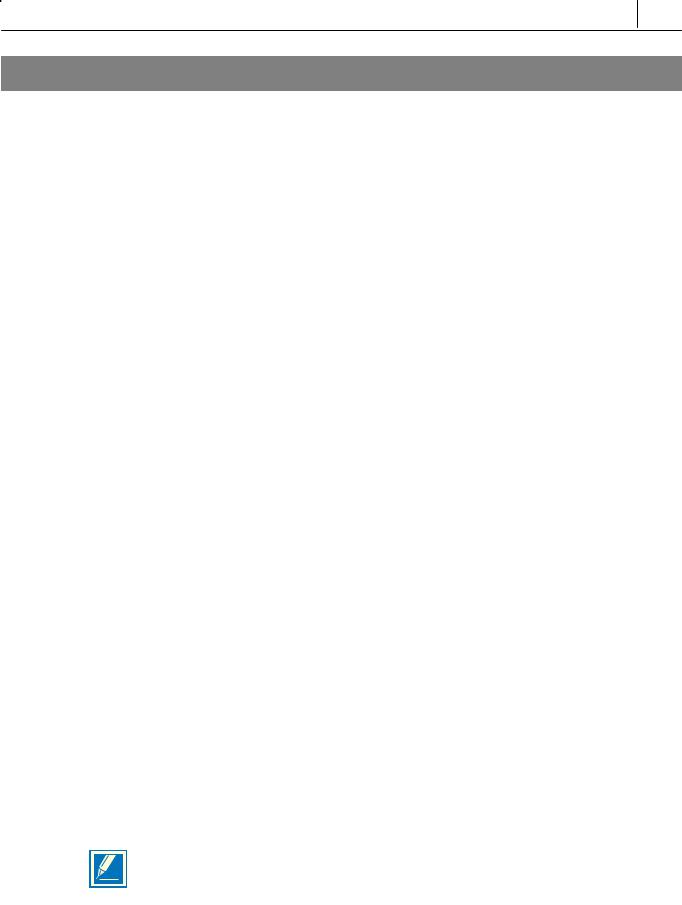
2-9
VOICE MAIL/AUTO ATTENDANT INTEGRATION
This section focuses mainly on in–band integration.
Because of the increased popularity of voice mail and auto attendant use, DCS-816 includes many programmable options to address this demand. The degree of integration that can be achieved depends on the abilities of the voice mail/auto attendant (VM/AA) system as well as the telephone system.
This list details the capabilities provided by the DCS-816 for voice mail via in–band integration.
Hardware Provisions
The VM/AA system must be connected to single line circuits on any SLI port.
Each port is equipped with a dedicated DTMF receiver for detecting DTMF signalling from the VM/AA.
These ports also provide an instant break in loop current when the calling party hangs up. This is called a disconnect signal.
Software Provisions
SCREENED OR UNSCREENED TRANSFER
There are no special codes needed to transfer a call. Simply hookflash, receive transfer dial tone and dial the destination.
DIRECT IN LINES
Any C.O. call can be assigned to ring at an individual station or a station hunt group assigned to the VM/AA.
CALLS OR RECALLS TO THE OPERATOR
Dialling 0 will always result in a ringback signal. If the operator is busy, the call continues to ring in queue to the operator. This prevents a caller from dialling 0 and reaching another mailbox because the operator is busy.
MESSAGE WAITING
A VM/AA port can leave a message at any station or group of stations. The message waiting indication can be set or cancelled at any station or station group with or without the stations ringing.
IN–BAND SIGNALLING
DCS-816 can be programmed to send the calling station’s extension number after the voice mail system answers. These DTMF signals may include a leading digit to indicate the type of call and additional information about the original caller. DTMF signals may also be substituted for call progress tones to speed up voice mail call processing. This program allows call forwarding to a mailbox and bypassing of the main greeting for automatic message retrieval. Blind transfers may be performed because the recall will be correctly identified.
The effectiveness of this program depends on the ability of the voice mail system to make use
of this information.
NOTE
STATION HUNT GROUP WITH OVERFLOW
Each station group can have an individual overflow destination with an individual overflow timer. The overflow destination will ring whenever a call to the group is not answered. If the voice mail system becomes inoperative, calls are automatically routed to the overflow destination.
Technical Manuals Online! - http://www.tech-man.com

2-10 Chapter 2
Programming Procedures
INTERNAL CALL FORWARDING TO VOICE MAIL
This option in MMC 300 will allow or deny intercom calls from following call forward to voice mail. This feature conserves disk drive space by only storing calls originating outside the system.
ONE–TOUCH VOICE MAIL ACCESS
One–touch speed dial keys can be programmed to automatically dial, log into and retrieve messages from voice mail.
CALL PROGRESS TONES
The only tones sent to a VM/AA port are dial tone, busy and ringback. To eliminate confusion, busy tone is substituted for DND or error tones on voice mail ports only.
Technical Manuals Online! - http://www.tech-man.com

2-11
INDIVIDUAL STATION PAGE
The system was not designed to permit page announcements to individual keysets. However, a forced auto answer key (FAUTO) can be used to accomplish this.
1.Program a keyset for RING in MMC 103.
2.Assign an FAUTO key to each keyset that is allowed to page individual keysets.
3.Call another station. When you hear ringback tone, press the FAUTO key. The ringing will stop and an Auto Answer call is set up.
To prevent the use of this feature from getting out of control, only assign FAUTO keys to those
keysets needing to page individual keysets.
NOTE
Technical Manuals Online! - http://www.tech-man.com

2-12 Chapter 2
Programming Procedures
CALLING LINE INDICATION PRESENTATION (CLIP)
Hardware Provisions
ISDN trunk cards
Software Provisions
The MMCs related to CLIP are listed below with a short description of their use. They are listed in the recommended order in which they should be programmed. This sequence is suggested so that the installer gets a better understanding of how the feature works. There is no technical reason to follow this sequence.
zMMC 312 ALLOW CLIP |
This MMC is used by the technician to |
|
determine which keysets are allowed to receive |
|
CLIP displays. |
zMMCs 722 and 723 |
These MMCs have had new keys related to |
|
CLIP features added to them. It is strongly |
|
recommended that all keysets allowed CLIP in |
|
MMC 312 are programmed with a CLIP key. |
zMMC 728 CLIP TRANSLATION |
This MMC allows the technician to create a list |
|
of names that correspond to numbers received |
|
from the Central Office (C.O.). These names will |
|
be displayed when a call rings in that has |
|
NUMBER ONLY data provided by the C.O. |
zMMC 725 SMDR OPTIONS |
The ability to print CLIP data and abandoned |
|
calls has been added to this MMC |
zMMC 119 CLIP DISPLAY |
This MMC is used by the end user to determine |
|
which piece of CLIP data is displayed when a |
|
call rings at the user’s station. |
zMMC 501 SYSTEM TIMERS |
This MMC has two new timers related to CLIP. |
|
The only timer that may need adjustment is the |
|
CLIP DISPLAY TIME. This is the length of |
|
time that CLIP data is displayed after the CLIP |
|
key is pressed. |
zMMC 415 TRK ABANDON |
This MMC is used by the technician to |
|
determine which trunks will record data in the |
|
Call Abandon list and print with an Abandon “A” |
|
flag on SMDR. |
zMMC 608 CLIP BLOCK |
This MMC is used by the technician to assign |
|
CLIP Review blocks to keysets to allow the |
|
user to review CLIP data for previous calls. |
Technical Manuals Online! - http://www.tech-man.com

|
2-13 |
zMMC 701 CLASS OF SERVICE |
All of the CLIP features have been added to this |
|
MMC to enable the technician to allow or deny |
|
them. |
zMMC 724 NUMBER PLAN |
CLIP features have been added to this MMC to |
|
allow a technician to assign an access code |
|
where necessary. |
Technical Manuals Online! - http://www.tech-man.com

2-14 Chapter 2
Programming Procedures
TOLL RESTRICTION (CALL BARRING)
OVERVIEW
DCS-816 allows each station to be assigned a class of service (COS) for use in the day mode and a COS for use in the night mode. This COS determines the station’s dialling class, which can be set to A through H.
Class A has no general restrictions and is not configurable but it will follow the restrictions set in the Class of Service table (see MMC 701) and Class H is restricted to internal calls only.
Classes B, C, D, E, F and G are controlled by the entries listed in the deny table in MMC 702, the allow table in MMC 703 and the wild cards defined in MMC 704.
Toll Restriction (Call Barring) Rules
1.The deny entries prevent certain numbers from being dialled. The allow entries are the only exceptions to these deny entries.
2.Listing numbers in the allow tables without any entries in the deny tables is the same as having no restriction.
3.When changing any entry or BCDEFG status, you must enter all digits.
The system has a Wild Card facility, these wildcards consists of three characters (X, Y or Z), these characters can be set to equal all DTMF digit from 1~9, 0, and #.
The following examples are provided as an aid to help understand how to use the deny and allow tables.
Example
Customer requirements:
zPhones with dialling class B can only dial local calls (i.e. cannot dial any number starting with 0)
zClasses C and D are restricted (denied) from dialling 0860 and 0850 numbers.
zClasses E and F are restricted from dialling 0891 and 0898 numbers.
zClass G can dial any number.
zAll classes except B can dial 192
zAll classes can dial 999 calls.
Technical Manuals Online! - http://www.tech-man.com
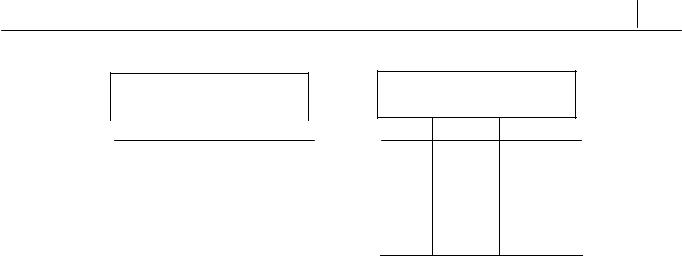
2-15
Toll Deny Table
|
Entry |
Digits |
BCDEFG |
|
|
001 |
0 |
100000 |
|
|
002 |
0850 |
111000 |
|
|
003 |
0891 |
100110 |
|
|
004 |
0898 |
100110 |
|
|
005 |
192 |
100000 |
|
|
006 |
0860 |
111000 |
|
Toll Allow Table
Entry Digits BCDEFG
0001 01865 111111
The entry in the toll allow table is used to override the toll deny table for specific numbers, i.e. all classes (even class B) can dial 01865.
Technical Manuals Online! - http://www.tech-man.com

2-16 Chapter 2
Programming Procedures
(This page is left blank intentionally.)
Technical Manuals Online! - http://www.tech-man.com

Technical Manuals Online! - http://www.tech-man.com
Technical Manuals Online! - http://www.tech-man.com
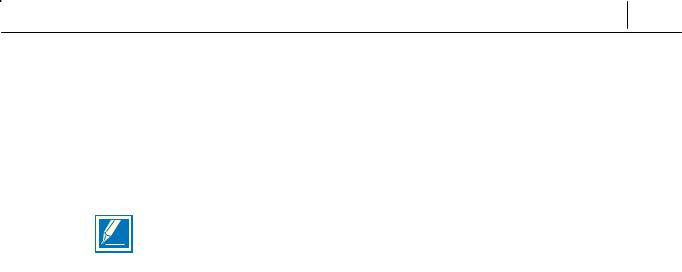
3-1
Chapter 3 Programming Using MMCs
This section explains how to1 program using the MMCs. You should read the instructions for each program carefully before starting the program.
First, decide what changes are required to the system, and therefore which MMCs you need to use. Then, “ENABLE” the keyset and follow the procedure for your selected program(s).
The default data of each MMC may vary according to each country.
NOTE
Technical Manuals Online! - http://www.tech-man.com
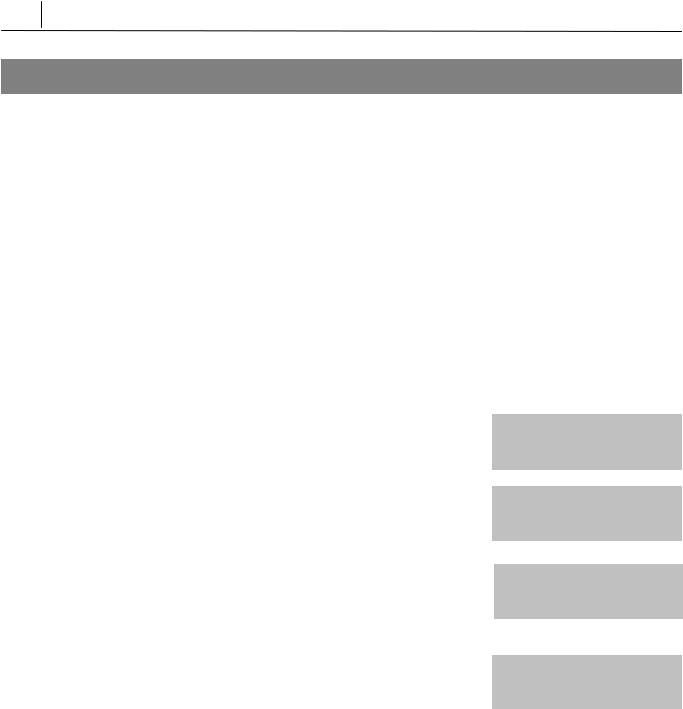
3-2 Chapter 3
Programming Using MMCs
100 STATION LOCK
Allows the system administrator or technician to lock or unlock an individual station or all stations simultaneously. The three options are as follows:
0 |
UNLOCKED |
Unlocks a locked station. |
1 |
LOCKED |
OUTNot allowed to access C.O line for dial out |
2 |
LOCKED |
ALLNot allowed to initiate any action with this mode |
PROGRAM KEYS
UP & DOWN |
Used to scroll through options |
KEYPAD |
Used to enter selections |
SOFT KEYS |
Move cursor left and right |
SPK |
Used to store data and advance to next MMC |
HOLD |
Used to clear previous entry |
ANS/RLS |
Used to select ALL |
ACTION
1.Press TRSF 100 Display shows
2.Dial station number (e.g., 205) OR
Press UP or DOWN to select station and press RIGHT soft key to move cursor
Press UP or DOWN to select station and use RIGHT soft key to move cursor
OR
Press ANS/RLS to select all stations
3.Enter 0 to unlock or 1 to lock (e.g. 1)
OR
Press UP or DOWN key to make selection and press
Use UP and DOWN key to make selection and press
RIGHT soft key to return to
4. Press TRSF to save and exit OR
Press SPK to save and advance to nex MMC
DEFAULT DATA
All stations unlocked
RELATED ITEMS:
Station user programming
DISPLAY
[201] STN LOCK UNLOCKED
[205] STN LOCK UNLOCKED
[ALL] STN LOCK
??
[205] STN LOCK LOCKED OUT
Technical Manuals Online! - http://www.tech-man.com
